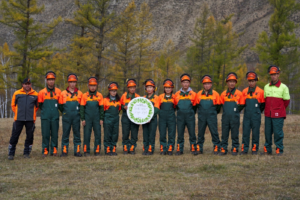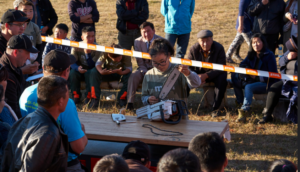Introduction
Forestry is considered a gender blind sector naturally, because it is traditionally a male
dominated, labor intensive sector. Internationally, women’s role in forestry is becoming vital for
their positive contributions in terms of farming and food production in agroforestry production
which brings additional task onto their already overwhelming responsibilities of household duties,
raising and taking care of their children and conducting animal husbandry.
Mongolia on the other hand is a special case, because not only are women the primary users of
forest resources, but also women, much more than men in this sector have received formal
education, hence most FUGS and Forest enterprises are led by women. There are a total of
1,106 registered Forest User Groups (FUGs) in Mongolia with nearly 25,000 members (of which
57% are women) who have ownership and access to 2.3 million hectares of forested land1. In
Mongolia, women have active engagement in reforestation, protection, production and many
other duties while they are less represented in decision making and even lower levels of
participation and benefit from productive work. Women’s role in this sector enhances prospects
for sustainable forest management, ensuring an equitable distribution and benefits and in
enhancing the efficiency of policy implementation, making Mongolia a very special case for
study.

Programme Background
The Biodiversity and Adaptation of Key Forest Ecosystems to Climate Change II Programme is
being implemented with the objective to ensure that stakeholders of the forestry sector in
Mongolia adopt proven concepts for the conservation and sustainable use of the forest
ecosystems and its biodiversity integrating climate change considerations.
Phase II of the programme started in March 2015 and will be completed in December 2018, implemented within a
scope of 5 aimags which include Selenge, Khuvsgul, Zavkhan, Khentii, and Tuv aimags.
The programme has three main outputs:
– Improvement of the legal and regulatory environment
– Improving Sustainable forest management
– Piloting of an integrated education system for the planning, implementation and control of sustainable forest management.
Promoting Gender Equality
Mongolia has a relatively high level of gender equality and social participation across sectors,
urban and rural. Women have equal rights and access to education and healthcare, resources
and other social benefits. The main visible disadvantage is within the context of securing upper
management positions in decision/policy making processes.
The Challenge
In the Environmental sector, Forestry activities are mainly carried out by family run forest
enterprises, FUGs, forest units and the like where the workload can be distributed evenly among
men and women of what is physically and feasibly appropriate. Certainly forestry work is already
classified as a 3-D job: dirty, difficult and dangerous, highlighted by many international
organizations. But, in Mongolia foresters work in even extreme natural conditions2 without the
availability of the latest forestry equipment, technology and proper safety gear. With this said,
men who take on these forest works deep in the middle of the woods face the risk of injury,
heavy machinery related accidents, rock falls, and other health conditions such as hypothermia
and dehydration.
When accidents do occur, the spouse, women and children are usually left behind are
challenged to take on the role of providing for their livelihood. There are also many single-mother
households wehre many of these women face challenges of securing access to natural
resources. In order to mitigate this challenge, the Programme focuses on supporting women in
capacity development in generating value from natural resources.
Our contribution
Our programme falls under the GG1 category. Therefore, within the scope of the project, we
have applied pilot implementation of education system for the operational planning, forest
management planning and individual planning, execution and controlling of silvicultural
measures. Accordingly, a gender sensitive curriculum was developed and applied to all
Vocational Training and Polytechnic Centers. The vocational schools are indicated to train 50
forest workers in the dual system for forest practices of which 40% are supposed to be women.
During programme baseline period there were only two vocational schools with segregated
training courses for regeneration and logging, of which 25% of the students were female. The
goal of the programme is to ensure balanced gender ratio among the trainees of a minimum of
40% women3. Currently the programme cooperates with five vocational training schools that
have qualified staff and trainers, implementing proven concepts and materials, fully capable of
conducting a modern forest vocational training in line with dual vocational education system
principles.
Integrated vocation education and training
Trainings conducted Male Female
2015 24 62% 38%
2016 56 57% 43%
2017 55 55% 45%
The programme ensures five forest enterprises to employ forest workers trained in dual forest
vocational education of which, 25% of which must be women. Programme baseline has no forest
enterprises that have officially employed forest workers trained in dual system.
Gender as a quality feature of our work
Our programme ensures gender equality in participation and opportunities for access to
resourcesm providing the latest necessary tools, equipment, machinery and safety gear and
continious trainings to foresters, members of FUG, FU, FEs and forestry students with additional
capacity building trainings to and with relevant state and local institutes and departments.
With these advancements in forestry technology and equipment, women today can be more
involved in wood preparation and production rather than just menial jobs in the sawmills or
plantation nurseries. Unlike many other developing countries, Mongolia in terms of renumeration
is equal for both men and women, and working conditions are not as dangerous for women in
terms of intense manual labor or prostitution, because most people working in the forest industry
are based on family businesses. Due to the intensive labor associated with wood preparation,
usually men are dominant in this task, whereas 10 out of 15 workers are women in wood
production.
Every year our programme organizes Open Door Days with partner Vocational and Technical
Polytechnic Centers and Technical and Vocational Education and Training schools to raise
public awareness about the forestry sector and the importance of forestry professionals. During
these events, it has become tradition to organize Forestry Skill Competitions among students
and professionals. Female students perform just as well during these competitive events, if not
more than male students, demonstrating women too are strong and skillful.
Our partners, stakeholders and beneficiaries are very aware of gender issues, and our gender
based approach to our daily activities, implementation and materials. Perhaps this is mainly
because women in Mongolia are strong willed, more women than men have received formal
education and are highly engaged in all aspects of domestic and professional life.
The programme considers gender equality in all activities, most especially mentioned in the
intervention area of vocational education. We place special importance raising gender
awareness across the sector through gender sensitive planning, implementation, reporting,
evaluation of project activities in addition to highlighting gender in all public outreach and
awareness materials, events, and procedures.
Cooperation
During phase I of the programme in 2013, we conducted a sector wide gender analysis which
resulted in the development of an Environmental Sector Gender Strategy in 2013, non-existent in
any other sectors in Mongolia. This has been the guiding document for implementing a gender
sensitive Green Development Concept in cooperation with national and international
stakeholders and beneficiaries in three stages from 2014-20304. Now, in the second phase of the
Programme, we are assessing the implementation5 of the Environmental Gender Strategy.
In additional to cooperating with the state and local governments, relevant agencies and
institutions, there are approximately 1,106 forest user groups in Mongolia, of which
approximately 40% have female leaders, that the programme directly and indirectly cooperates
with. The number of female members within these formally established forest user groups is
increasing and their participation and roles within these organizations are essential for success.
To prepare future generations of skilled and competent foresters, the programme has organized
workshops for high school students in target aimags to educate students on the importance of
choosing their majors and future profession while explaining how interesting the forestry
profession can be, empowering young girls they can also become leaders in the protection and
preservation of our natural resources.




